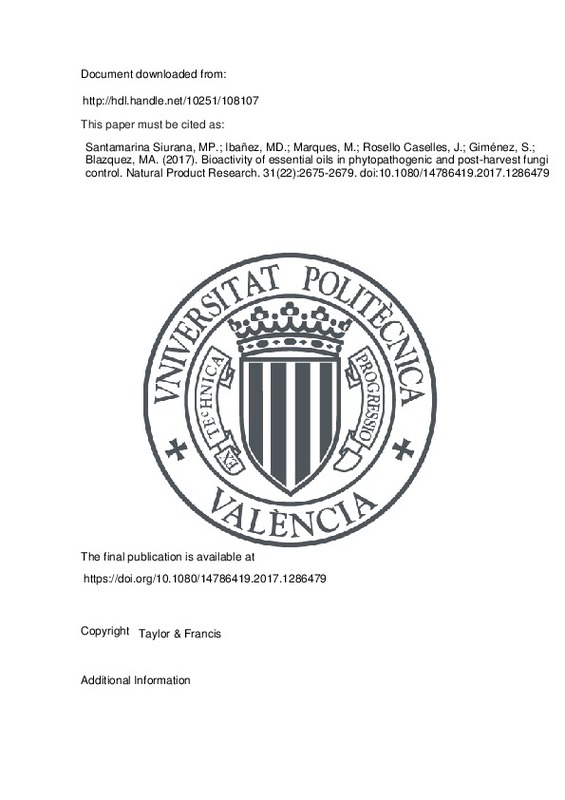JavaScript is disabled for your browser. Some features of this site may not work without it.
Buscar en RiuNet
Listar
Mi cuenta
Estadísticas
Ayuda RiuNet
Admin. UPV
Bioactivity of essential oils in phytopathogenic and post-harvest fungi control
Mostrar el registro sencillo del ítem
Ficheros en el ítem
| dc.contributor.author | Santamarina Siurana, Mª Pilar
|
es_ES |
| dc.contributor.author | Ibañez, M. D.
|
es_ES |
| dc.contributor.author | Marques, M.
|
es_ES |
| dc.contributor.author | Rosello Caselles, Josefa
|
es_ES |
| dc.contributor.author | Giménez, S.
|
es_ES |
| dc.contributor.author | Blazquez, M. A.
|
es_ES |
| dc.date.accessioned | 2018-09-25T07:48:51Z | |
| dc.date.available | 2018-09-25T07:48:51Z | |
| dc.date.issued | 2017 | es_ES |
| dc.identifier.issn | 1478-6419 | es_ES |
| dc.identifier.uri | http://hdl.handle.net/10251/108107 | |
| dc.description.abstract | [EN] Commercial thyme and lavender essential oils were analysed by GC/MS. Sixty-six compounds accounting for 98.6¿99.6% of total essential oil were identified. Thymol (52.14 ± 0.21%), followed by pcymene (32.24 ± 0.16%), carvacrol (3.71 ± 0.01%) and ¿-terpinene (3.34 ± 0.02%), were the main compounds in thyme essential oil, while large amounts of oxygenated monoterpenes linalool acetate (37.07 ± 0.24%) and linalool (30.16 ± 0.06%) were found in lavender one. In vitro antifungal activity of the essential oils was evaluated at 200 and 300 ¿g/mL against 10 phytopathogenic and post-harvest fungi, which significantly affect agriculture. Micelial growth inhibition was calculated for each tested fungus and dose. Thyme essential oil showed satisfactory results with 90¿100% growth inhibition in almost all the assayed fungi at 300 ¿g/mL, while lavender essential oil showed no noteworthy inhibition data at either dose, and its growth was even enhanced. Thyme essential oil represents a natural alternative to control harvest and post-harvest fungi, and to extend the shelf-life of agriculture products. | es_ES |
| dc.description.sponsorship | This study has been financed by the Spanish Ministry of Economy and Competitiveness, Programme-oriented Societal Challenges 2014-2017 [grantnumber AGL2013-42989-R-AR]. | en_EN |
| dc.language | Inglés | es_ES |
| dc.publisher | Taylor & Francis | es_ES |
| dc.relation.ispartof | Natural Product Research | es_ES |
| dc.rights | Reserva de todos los derechos | es_ES |
| dc.subject | Lavender | es_ES |
| dc.subject | Thyme | es_ES |
| dc.subject | Essential oils | es_ES |
| dc.subject | Antifungal activity | es_ES |
| dc.subject.classification | BOTANICA | es_ES |
| dc.subject.classification | BIOLOGIA VEGETAL | es_ES |
| dc.title | Bioactivity of essential oils in phytopathogenic and post-harvest fungi control | es_ES |
| dc.type | Artículo | es_ES |
| dc.identifier.doi | 10.1080/14786419.2017.1286479 | es_ES |
| dc.relation.projectID | info:eu-repo/grantAgreement/MINECO//AGL2013-42989-R/ES/NUEVOS MATERIALES BIODEGRADABLES MULTICAPA PARA ENVASADO ACTIVO DE ALIMENTOS SENSIBLES AL DETERIORO MICROBIANO Y%2FO OXIDATIVO/ | es_ES |
| dc.rights.accessRights | Abierto | es_ES |
| dc.date.embargoEndDate | 2018-12-31 | es_ES |
| dc.contributor.affiliation | Universitat Politècnica de València. Escuela Técnica Superior de Ingeniería Agronómica y del Medio Natural - Escola Tècnica Superior d'Enginyeria Agronòmica i del Medi Natural | es_ES |
| dc.contributor.affiliation | Universitat Politècnica de València. Departamento de Ecosistemas Agroforestales - Departament d'Ecosistemes Agroforestals | es_ES |
| dc.description.bibliographicCitation | Santamarina Siurana, MP.; Ibañez, MD.; Marques, M.; Rosello Caselles, J.; Giménez, S.; Blazquez, MA. (2017). Bioactivity of essential oils in phytopathogenic and post-harvest fungi control. Natural Product Research. 31(22):2675-2679. doi:10.1080/14786419.2017.1286479 | es_ES |
| dc.description.accrualMethod | S | es_ES |
| dc.relation.publisherversion | https://doi.org/10.1080/14786419.2017.1286479 | es_ES |
| dc.description.upvformatpinicio | 2675 | es_ES |
| dc.description.upvformatpfin | 2679 | es_ES |
| dc.type.version | info:eu-repo/semantics/publishedVersion | es_ES |
| dc.description.volume | 31 | es_ES |
| dc.description.issue | 22 | es_ES |
| dc.relation.pasarela | S\355701 | es_ES |
| dc.contributor.funder | Ministerio de Economía, Industria y Competitividad | es_ES |







![[Cerrado]](/themes/UPV/images/candado.png)

